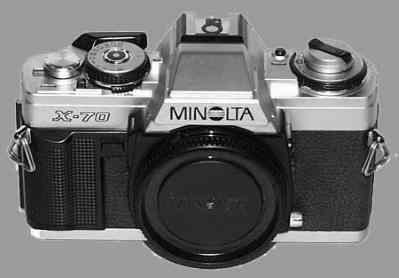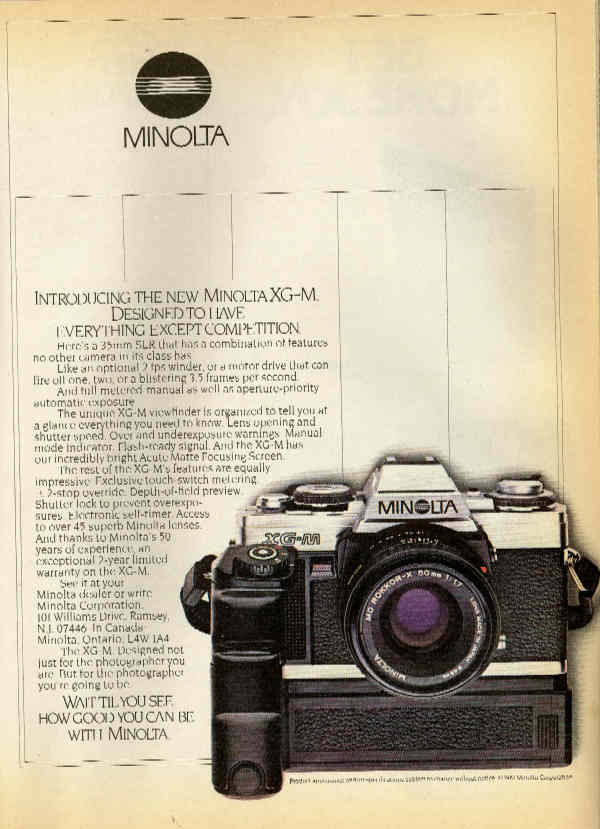

XG-M
(1981) The XG-9 of 1979 was the top of the line camera in the XG series, but it had one major drawback -- it lacked a metered-manual mode. Sure, it had manual settings of the shutter speed, but the meter turned off when these were used. This kept enough consumers away that Minolta decided in 1981 to upgrade the XG-9, and it produced the XG-M. It is a modified version of the XG-9 but with several new features, including a new body style with a built-in grip on the body. The old XG-style body was small, light and comfortable, but Minolta thought they could improve on it.
This was the first Minolta camera with the new company logo, and it added several improvements to the XG line of cameras. First, was the new 3.5 frames per second motor drive accessory, the MD-1. This was Minolta's first detachable motor drive operating at speeds above two frames per second, and would be usable on most of Minolta's later cameras. However, it was not usable on the earlier XG cameras. Secondly, the new body style of the XG-M eliminated the combined "ON/OFF/SELF-TIMER/BATTERY CHECK" switch of the XG series, and moved these features around the camera. First, the self-timer switch was moved from the top of the camera to the front of the camera -- a design style seen on the remainder of Minolta's manual cameras. The ON/OFF switch was switched to the shutter speed dial. At the same time, the exposure compensation selector and film speed selectors were moved away from the shutter speed dial and over to the rewind crank -- where it had been on the earlier XE and XD cameras. But, since that's where the ON/OFF switch, and battery check are on XG cameras, this meant that these had to be moved. Well, these moved over to the shutter speed dial, where the exposure compensation selector and film selector used to be. For some reason, Minolta thought this was progress. Perhaps the previous setup was too expensive to manufacture, more prone to errors (both mechanical and user-related), or excessively costly to repair. Anyway, the basic features are the same as with the earlier XG cameras, they are just in different places -- something to keep in mind when you are buying a second camera body. If you are familiar with the older XG cameras, the XG-M might not "fit in" even though it is, technically, an XG series camera.
On the earlier XG cameras, the meter shuts off when the camera is used in manual mode. This was done to avoid confusion. In automatic-exposure mode, the LED scale displays the metered shutter speed which is the speed that will be set automatically by the camera. But when the camera is set to manual mode, the single LED scale could only display one speed. Should it be the metered speed or the manually set speed? Minolta's previous auto-exposure cameras, like the XE-7 had two displays when in manual mode -- one for the manually set shutter speed and one for the metered shutter speed. The XG cameras dropped the dual displays -- to save money -- and opted to shut off the meter in manual mode -- so as not to confuse the user about what speed was displayed. Needless to say, may people preferred to see BOTH speeds in the viewfinder, and the XG-M attempted to address this issue.
The viewfinder on the XG-M was nearly identical to that of the
XG-9. The main difference is that with the XG-M,
the LED meter readout does not shut off in manual mode. Instead, it
displays an "M" in the viewfinder to remind you that you are in manual mode
-- as well as displaying the recommended (metered) shutter speed.

In manual mode, the shutter speed that has been manually selected is not displayed in the viewfinder -- just an "M" -- below the 1 second LED. This addressed, but did not solve, the original problem -- which still can lead to confusion. It's easy to assume that the speed in the viewfinder is the SET shutter speed and not the METERED shutter speed -- since you are in manual mode, after all. Minolta would address this problem, on later camera models, by having the AUTOMATIC shutter speed blink and the METERED shutter speed not blink on the same LED scale. Perhaps the best approach is the viewfinder of the XE-7. It had a window which showed the set shutter speed (and another for the set f-stop), and a needle on a shutter speed scale to show the metered speed. There was never any doubt about what the shutter speed was actually set at and what the camera recommended. In automatic mode, the shutter speed window displayed an "A" -- the opposite of the XG-M. It's unfortunate that Minolta didn't use the tried and true XE-7 approach with the XG-M. They could have, and the camera would have been a marvel. They came so close with the XG-M! The LED scale in the XG-M displays the metered (AKA, recommended) shutter speed whether in automatic exposure mode or manual exposure mode. If you are working in manual mode, you still have to take your eye away from the viewfinder to set the shutter speed that you manually want to employ. Why Minolta chose to simply place an "M" instead of the actual set shutter speed will remain a mystery.
There were actually two versions of the XG-M, depending on the market.


The XG-M was a big step up for the XG series. It now had a near-complete set of features, and could compete with the higher-priced XD cameras. In fact, the XG-M had some advantages over the XD series, such as it's faster motor drive and "Touch-Switch". But the XG-M was soon to be out-paced. Minolta had decided to move away from the XD and XG series, and start a whole new line of cameras, beginning with the X-700 the same year. For a comparative look at the major features of the XG-M, check out MINMAN's SLR table -- the world's most complete!

RETURN TO THE MANUAL
MINOLTA HOME PAGE
We didin't want to do this, but since other websites have been stealing our stuff, we have no alternative but to state:
COPYRIGHT@1995-2023 by Joe McGloin.
All Rights Reserved. The material on this website is protected by US Federal copyright laws. It cannot be copied or used in any manner without specific approval from the owner.
The material on this website is protected by US Federal copyright laws. It cannot be copied or used in any manner without specific approval from the owner.